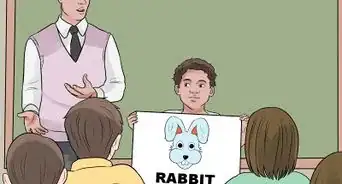X
wikiHow is a “wiki,” similar to Wikipedia, which means that many of our articles are co-written by multiple authors. To create this article, volunteer authors worked to edit and improve it over time.
This article has been viewed 25,073 times.
Learn more...
Teaching a non-verbal special needs child requires patience, good observation skills and a willingness to collaborate with all of the parties involved in the child's upbringing. This is a unique skill that takes time to nurture and perfect but a willingness to teach such children is the most important factor.
Steps
-
1Observe the child. Since the student is non-verbal, as a teacher, you must collect data and watch the student's behavior. Over time, you will be able to find and understand the student's temperament and understand the body language of the student. This will be unique to each student and is not something that can be rushed.
- Their typical movements may be jerky or forceful, causing them to be misread as "angry" even though they are not mad.
- Watch for anxiety. Many disabled children are also anxious and afraid of criticism.
-
2Collaborate with the child's caregivers. This stage is difficult because the parents and or guardians tend to give little information about their special needs child. The parent may have concerns because if the child is aggressive, they don't want the teacher to know that. However, building a relationship with the parent or guardian can be beneficial because both parties can work on the same goal and objectives.
- Be very careful if a caregiver describes a child as "manipulative" or "naughty." This may mean that the caregiver is ignoring or behaving destructively towards the child.
Advertisement -
3Start teaching. This is where you can start teaching objectives and learning components for the non-verbal student. The use of objects, visuals, and teacher-generated resources that the student can touch should be used. This is also the stage where comprehension will become evident and you can use this to build on old activities and introduce new ones.
-
4Create routines for the non-verbal student. Routines help the student to know what to expect; surprises are not helpful in this environment. Be patient about progress and comprehension; bear in mind how difficult it would be to not be able to speak or express your feelings, ideas and reasoning.
-
5Focus on developing communication skills. It may not be possible for the child to speak yet, but that doesn't mean the child won't be able to communicate. Focus on teaching the child to express basic needs, and then move on to more advanced subjects. Here are some methods that the child may be able to use: \
- Picture exchange systems
- Baby Sign (which can later turn into more advanced sign language)
- Typing
-
6Honor all forms of communication (yes, even behavior). Flopping on the floor means something. Crying means something. If you work with the child, and try to figure out what they need, it will encourage them to communicate with you. Once they know you'll listen, they'll start working harder to open up. Here are some useful phrases:
- "You look stressed—your face is all scrunched up and you're frowning. Is something wrong?"
- "Do you need a break?"
- "Can you point to the thing you want?"
- "I know it's frustrating trying to communicate. I'm frustrated too. I still don't understand, but I care about what you have to say."
-
7Gently encourage speech if the child begins learning to use it. For example, if the child points to a banana, hold it up and say "banana." Encourage the child to do so. If they cannot, try encouraging them to make the "b" or "ba" sound. Let them try, and then give it to them.
- If the child can't do it, or doesn't have the energy, don't push it. You can try again later.
- Praise their efforts, successful or not.
-
8Assume that any repetitive or unusual motions are important. Some disabled children (especially autistic children) will "stim," or stimulate their senses through repetitive or other behavior. This can help them calm down, express their emotions, handle difficulty, or maintain a sense of well-being.
- Recognize that they can pay attention to you while stimming—in fact, it may be the only way they can do so.
- Sometimes stimming will give you a clue regarding how they are feeling.
- Never say "quiet hands" to them, grab them against their will, or attempt to make them indistinguishable from their peers.
-
9Respond compassionately to behavioral issues. Special needs children may melt down in frustration or act out. Help them use calming strategies and figure out what the problem is.[1]
- Self-talk
- Chewing gum
- Deep breaths
- Counting
- Talking through the problem (validating their feelings)
-
10Do not allow other students to bully the child. Nonverbal children may be targeted for bullying. Model respectful behavior as a teacher/aide, and intervene firmly if you see any bullying happening.
- If a girl takes the child's toy and he hits her, then both his and her behavior need to be addressed.
- Don't make the child follow rules that other children can get away with bending or breaking.
- Don't force the child to interact with other children. Having no friends may be preferable to having friends who bully them when your back is turned. Let them make their own choices about friendships.
-
11Teach them about their disability. The child probably already knows they are different, but they may not understand why. Teaching them the basics of disability will help them understand what they're going through, so that as they age they can seek resources from disabled adults.
- "You have a disability called autism, which means you think differently. It's why you stim a lot, and why loud noises hurt you so much. It's also why you know so much about cats."
- "You go to Special Ed because you are disabled. This means you think a little differently, and some things are harder for you. It's okay to be disabled."
-
12Keep things fun. Remember, you are working with the child, not against them. Be their ally, encourage skills and independence, and enjoy your time together.
Advertisement
References
About This Article
Advertisement


































































